
Layth Sidiq will present Arabic Music on January 27th, a complimentary online lecture.
Let’s Duet! The Art of Playing Together
Wednesday, January 19th at 5:00 – 6:00 pm
You, too, can discover firsthand why playing an instrument with a friend makes music fun and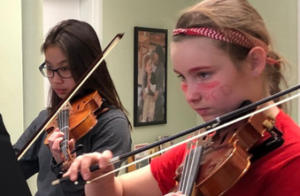 exciting!
exciting!
Join us for Let’s Duet! Exploring the Art of Playing Together workshop presented by CCM faculty member Kitty Cheung-Evans.
Register in advance! The workshop is free and open to all CCM students.
In this chamber music workshop, we’ll share ways of being a great duo partner and exploring the art of playing together. Plan to bring a duo partner or meet a new friend. Let’s go ahead and play some duets!
Arabic Music lecture
January 27th, 2022, at 7:00 pm
Discover Arabic music’s beautiful and diverse sounds with guest lecturer Layth Sidiq. Join us online on Thursday, January 27th at 7:00 pm when Layth, an award-winning violinist, composer, educator, and the current artistic director of the New York Arabic Orchestra, presents an exciting music history lecture. He’ll present us with the Arabic style, how it differs from Western music, demonstrating rhythms and patterns used most frequently in traditional/classical Arab music.
Sign-up in advance to receive the link to the lecture.
CCM Students Tackle the 4- Hand Duet Project
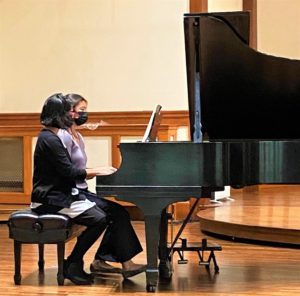 Those attending the November 20th CCM recital were rewarded with memorable piano duet performances by Melissa Tucker and two of her CCM students, Noelle Lee and Sneha Iyer. They performed Émile Jaques–Dalcroze’s 3 Bluettes, No. 1, No. 2, and No. 3.
Those attending the November 20th CCM recital were rewarded with memorable piano duet performances by Melissa Tucker and two of her CCM students, Noelle Lee and Sneha Iyer. They performed Émile Jaques–Dalcroze’s 3 Bluettes, No. 1, No. 2, and No. 3.
The duet project came about this past summer when inspiration came from Sneha, who was interested in connecting with other piano students her age. Although Noelle and Sneha attended high school in different towns, Melissa thought they’d make ideal collaborating partners.
To challenge her students while making it a fun experience, Melissa selected the 3 Bluettes, No.1, 2, and 3, for them to play together. The pieces are engaging rhythmically, with a mixed meter in the 3rd Bluette, yet it also introduces a variety of moods and expressive harmonies. Melissa provided the music published in Japan by one of her Dalcroze Eurhymic colleague’s mentors.
Both Noelle and Sneha were excited about the idea and eager to meet and begin learning the music. Each of them exchanged phone numbers and began communicating and immediately practicing. They worked at the end of the summer and throughout the fall to learn the music. As soon as they were ready, Melissa played the appropriate duet part with each of them in their lessons.
Eventually, they were ready to practice Bluette, No.2 together; on their own and within a shared lesson at CCM with Melissa. For a month before the recital, they began each lesson playing the entire set of 3 Bluettes as if in performance.
Melissa proudly tells us, “It was a joy to bring this project to fruition, to see Noelle and Sneha become friends, have fun making music together, and experience a spirited composition by Swiss musician and pedagogue, Emile Jaques-Dalcroze.” Dalcroze is the founder of the Dalcroze Eurhythmic approach to music education which incorporates an embodied study of music, movement, solfege, active listening, and improvisation.
Bravo Noelle and Sneha!
Are you a CCM friend yet?
Join us on Instagram and Facebook to be the first to learn CCM news and more! See what music videos we like, photos we post, practice tips and articles we suggest, and new music in the music world. Be sure to bookmark the CCM Blog to never miss a new post.
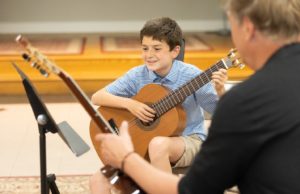
There are many skills that you develop as a musician here at the Concord Conservatory of Music, and it’s our objective to make sure that we provide you with the tools you will need to be successful. As part of your Musician’s Toolbox, it is important to include the ability to listen.
Listening is an integral part of all musical activity and learning. As an active listener, you develop the ability to sing or play in tune; stay in time; blend sounds; cultivate your own ideas about music, and deepen your appreciation of songs. Being an active listener means all you are doing is listening, not doing another activity with the music playing. The latter is called passive listening.
How do you actively listen? First, listen to the song. Then go back and listen for the rhythm, the melody, what’s going on in the background, the harmony.
What are the different instruments that are playing? Can you isolate what they are playing? What is the mood of the song? What key is the song written in?
We’ll provide you with some questions to think about when you listen to our monthly playlist. Check out your January Listening Project playlist and start discovering more about music in our world.
Monthly Playlist
Each month, we’ll be sending out an email alerting you to the new YouTube playlist selected by CCM faculty member Stephen Marotto. He will provide you with some background on the song and a question to think about while you’re listening. The playlist may include songs from a selected topic or genre and have pieces better-suited for our younger learners and adults.
Stephen says, “The CCM listening project is intended to expose our students to new sounds from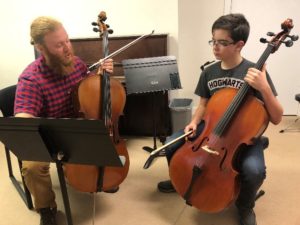 different parts of the world that they may not be familiar with. We also encourage them to develop their critical listening skills so they can identify and discuss different features of the music such as melody, harmony, timbre, texture, affect and mood, etc. Developing critical listening skills is an important step in each student’s musical journey.”
different parts of the world that they may not be familiar with. We also encourage them to develop their critical listening skills so they can identify and discuss different features of the music such as melody, harmony, timbre, texture, affect and mood, etc. Developing critical listening skills is an important step in each student’s musical journey.”
We encourage you to keep a Listening Journal and explore a variety of music outside of your regular selections.
One idea is to listen to variations of the song you are working on in your lesson. How is it different than the version you are learning?
Your CCM instructor will also ask you about the Listening Project playlist and your selections.

As a pianist, it’s not surprising to learn that CCM piano faculty member Keun Young Sun likes to keep her hands busy. “If I’m not playing the piano, or teaching I’m always knitting or crocheting, something to keep my hands occupied.”
When you think of a pianist, the vision that often comes to mind is a solo performer on the stage with a magnificent grand piano. And that is a path that Keun Young started down when she began her undergraduate piano studies in her home country of South Korea and continued while studying for her Masters in Performance at the New England Conservatory of Music. But that all changed. She came to realize that solo piano can be a lonely experience. “I felt lonely. I practiced alone, I performed alone, and I was nervous. When I was at NEC, I started to play more chamber music, and I found that I enjoyed the music more when I was sharing the experience of making music, and I also felt more comfortable on stage.”
Collaborative Piano
This insight started Keun Young on her second masters in Collaborative Piano. Why pursue a collaborative piano degree? How is it different from being a soloist or an accompanist? A solo pianist is just as it sounds, either entirely alone or the “main event” in front of an ensemble or an orchestra. On the other hand, the collaborative pianist focuses on partnering with other artists. They are someone who enjoys working with chamber musicians, and often soloists like vocalists, and being in their own right a talented performer. At many graduate university programs, collaborative students are cross-trained to work with both instrumentalists and vocalists, taking classes in opera and expanding their repertoire knowledge to perform with a wide-ranging community of musicians. Dr. Tim Burns at Colorado State University adds “that flexibility, grace under pressure, and deep observational and listening skills are essential qualities for a successful collaborative pianist.”
“When playing in a piano trio, you have to work together to make a beautiful sound, and you are working together to create the whole.” Keun Young elaborates that when working in a group, they discuss how best to perform the piece together as soloists and support each other on the main melody. “It’s finding the balance.”
Don’t be Selfish
As an instructor, she encourages her students to share their music. No matter what age, or ability, she believes that if you love music, you are giving a gift by sharing your music. She also encourages her students to feel the emotion of the music and teaches them to convey how they are feeling in the music they are playing. Keun uses an example of playing a song in a major scale and learning to play it “sadly.” “Music is a language to express your feelings and to tell your story.” Music can also help children ‘hear’ what certain emotions sound like.
As a way to share her music and bring more classical music concerts to her area community, Keun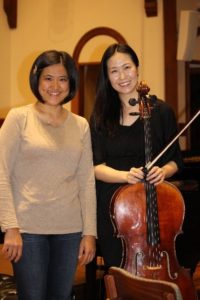 Young founded a concert series at her church. She did this not only because the area lacked free classical concert opportunities but mainly because she loves to play for other people, not just for herself. The series features chamber music and piano duos with guest artists. She also gives her gift of music weekly performing at a local nursing home.
Young founded a concert series at her church. She did this not only because the area lacked free classical concert opportunities but mainly because she loves to play for other people, not just for herself. The series features chamber music and piano duos with guest artists. She also gives her gift of music weekly performing at a local nursing home.
Outside of her music, she is outside with her family. They enjoy taking camping and hiking trips in New England. Last summer, they went to Vermont for a week-long camping trip, where it was pouring for the entire week. Many would have packed up and headed to find drier weather but not her family. “It was a special time, and I enjoyed hearing the rain on the tent. It was fun to make a fire in the rain and go on our hikes and swim in the rain.”
Asked what else she would be if not a pianist, Keun confesses that she wants to be a dog breeder. The owner of a golden retriever, as a child, her family had more than ten dogs at once in Korea.